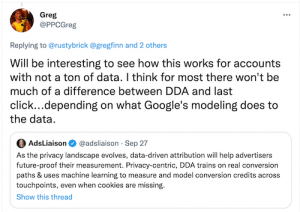— August 30, 2019
Customers are now assuming they can and will have a digital relationship with you. The more you make that possible, the more likely they are to buy from you. If you are truly making all that possible, removing all the barriers, your customers will be able to:
- Find you easily through search engine results, online advertising, online reviews, “[type of business] near me” searches, social channels, and online directories.
- Get all of their questions answered, when they come to your site or anywhere else you are offering your products (the questions they actually have, not the ones you assume they have. Make sure you also answer the question no one ever seems to answer: “What’s going to happen to me after I buy?”)
- Reach a human via chat, when they come to your site.
- Make buying decisions using a variety of tools and information you make available to them, including competitive comparisons, reviews, closeups, information about how the product is made or service is going to be performed, and so on.
- Carry out tasks—serve themselves—using tools you make available to them on your site, from any device (or even several devices, starting with one and then finishing with another).
This is the customer side of digital transformation. Businesses going through this digital business transformation process are digitizing both the customer-facing and the back-office aspects of their companies, which, in fact, go a long way toward making the customer side of the process work.
Doing business is a lot more competitive than it used to be, as we all know. Customers can just as easily buy from someone in China as they can from a local store. Actually, it is now easier to buy from someone in China than it is to get in your car, drive to the local store, and hope they have what you’re looking for. The web is the world’s biggest international shopping mall, no car needed.
Your competition is now anyone who makes the buying process easier than you do. This is the true essence of the digital transformation we are all living through.
What is really required to compete successfully in this environment? To give your customers the experience they expect?
Think of your business as an app
People use applications because they want to do something. They want to learn. Improve their lives. Solve a problem. Meet a need or desire. Accomplish something that they couldn’t accomplish before, or certainly not as easily.
So the first question you need to ask yourself and your team is: “What do they want to learn and do, with what we offer?” It will have to be a very free-thinking brainstorming session, because the answers may include products and services that you didn’t even think of offering before. More on that below.
Let’s say you own a company that sells a mechanical object, such as a thermostat. You’ve recently added digital intelligence to that object, so that it can be controlled digitally, and, further, connected it to the internet so that the object can be controlled by a mobile phone. You may realize, during this brainstorming meeting, that the anonymous data collected by all your devices could, in itself, be a revenue stream. You could sell reports to others about the normal house temperatures in different parts of the country, for example.
Or let’s say that you run a company that has a string of fitness centers in various locations. Your customers want to be able to interact with your gym, keeping track of their visits and the results of those visits. And maybe they want to interact with others who visit the gym, asking questions and sharing information with each other.
Or let’s say you are a local store and you want your customers to be able to ask questions, request that you carry new products, leave reviews, make suggestions, and so on. (One of the most common questions is, “Do you have [this product] in stock at the store, so it will be there when I drive over to get it?” Amazing how many companies do not answer this question.)
All of these examples require some sort of customer portal or dashboard, or even a very sophisticated app, where they can perform these tasks. Because of the interaction involved, not only with your customers but with the data and apps behind the scenes, you will need to work with a developer whose knowledge and experience goes beyond simple website HTML and CSS coding. As a reminder:
- HTML stands for “Hypertext Markup Language,” primarily used to control how a website presents its data to a user, and the creation of simple forms. It “marks up” or sets formatting rules for your site content.
- CSS stands for “Cascading Style Sheets,” and allows a developer to set universal rules for the appearance of your content, e.g., specifying that all headlines on all of your pages appear in bold, 30-point Helvetica. (Here’s another article that might be helpful for you to read before your developer starts trying to discuss programming languages with you.)
These are the passive design and formatting tools used by traditional website creators to make a pleasing website for your customers. But in order for a user to interact with the data in your backend systems, more sophisticated tools are required, such as Python or Javascript.
Realize that new business apps require new perspectives and processes.
Frank Zinghini and I recently discussed the “your business is an app” topic, at length, in our “Go Digital or Die” webinar series, Episode #3. (Once you sign in, you should have access to all the webinars in the series.) We talk about how, as a business owner, you need to change how you look at your business and even how you manage your business. This article complements that discussion.
So back to the concept that your new offerings will require new perspectives and processes. How do you make this work in your business?
First, you will need to look at your business from the outside in. From your customer’s perspective. The questions you’re trying to answer are:
- “What new products or services could we be offering, just by changing what we offer, and how we offer it?”
- “What could current or new customers do with our data or systems that would help them?”
In order to answer these questions, you should not start with the brainstorming meeting. If you do that, you will simply be talking to yourselves, discussing things you already know (or think you know) about your customers. Having interviewed literally thousands of customers for hundreds of clients, I guarantee that what you think is important to your customers—and how they think about what you sell—is going to mislead you. The “what’s important to our customers” list that the company execs give me is always different from the list of “what’s important to us” that I get from customers in interviews. My book spells out exactly how to conduct those interviews, in Chapter 3 (read the first two chapters first).
Use my book as a guide, interview 5 – 7 customers of a given type, asking open-ended questions that are in the book. But for this “turn my business into an app” exercise, also ask them what they wish they could do on your website; what they see your competitors doing that they think you should do; and other products and services that they might be interested in.
Armed and educated with this illuminating data (data you can trust, because it came from customers), now you can have a meaningful brainstorming meeting. The meeting will be focused on “how” you can meet those needs, which is the question that your team has to answer, and is equipped to answer. And you’ll have to be honest with yourselves about how good you have to be, in order to offer something that your competitors don’t offer or don’t do well.
Your goal is to identify what a digital customer relationship looks like for your company and your customers.
Avoid the most common mistake
As you start to develop your plan, make sure you avoid the mistake that almost every company makes when it embarks on pursuing a new revenue stream. Be aware of the fact that the new business will have a different rhythm, require different types of processes and people, will have its own unique set of “gotchas,” and may be much more expensive to build and grow than the business you are in now.
I especially see this as a problem when a company is moving from a product-centric business to a service-centric business. Or shifting either type (product or service) to an app-centric business. You will be hiring types of people you’ve never hired or managed before, and you will make mistakes.
Keep things as fluid as possible; hire employees on a 3-month trial or use freelancers for a while until you learn some lessons. And definitely consider opening a “division” or “skunk works” to run this project, so that the new effort won’t get bogged down by the current processes and systems.
Again, Frank Zinghini and I recently discussed this topic, at length, in our “Go Digital or Die” webinar series, Episode #3. Frank has helped many businesses create applications in order to realize new revenue streams, and I’ve helped many companies take these new products to market and realize revenue from them.
The information we share will help you move in the right direction and avoid making common mistakes as you work to become an active player in the digital environment.
Digital & Social Articles on Business 2 Community
(34)







